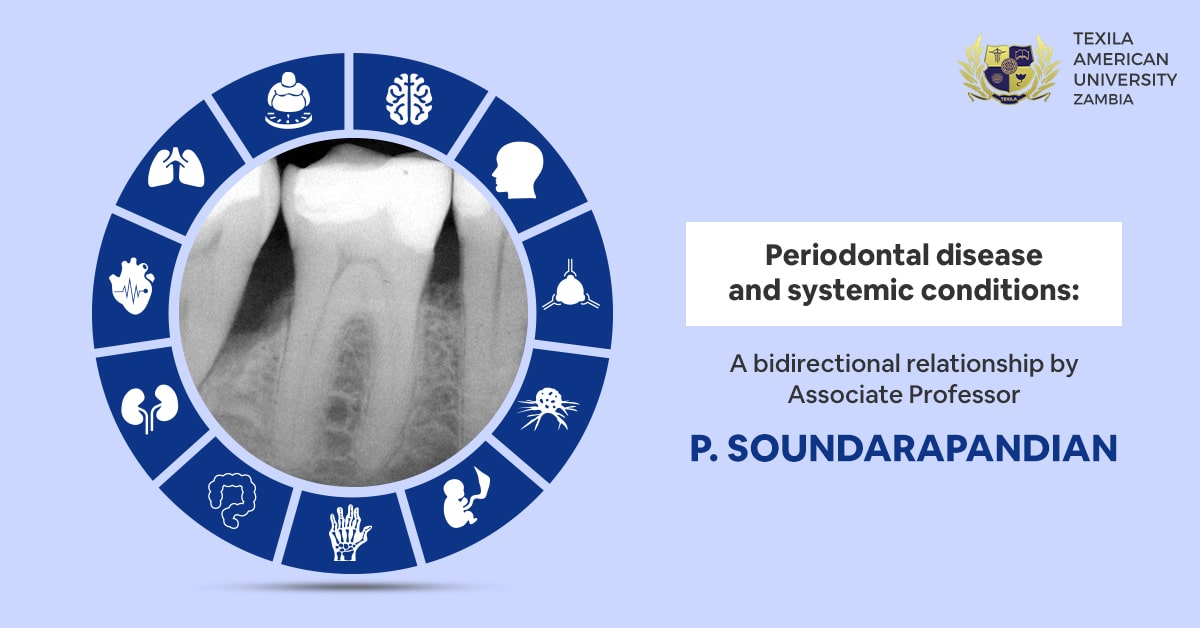|
Tired of Reading? Please listen to the blog
|
Blog Summary
Periodontal disease is the inflammation in the tissues surrounding the teeth due to bacterial accumulations. Recent findings suggest that oral health might indicate systemic conditions such as cardiovascular disease, type 2 diabetes mellitus, adverse pregnancy outcomes, and osteoporosis. Dentists and physicians advocate controlled clinical trials to substantiate the association between periodontal disease and systemic conditions.
For decades, physicians and dentists have paid close attention to their own respective fields, specializing in medicine pertaining to the body and the oral cavity, respectively. However, recent findings have strongly suggested that oral health may be indicative of systemic health.
Currently, this gap between allopathic medicine and dental medicine is quickly closing, due to significant findings supporting the association between periodontal disease and systemic conditions such as cardiovascular disease, type 2 diabetes mellitus, adverse pregnancy outcomes, and osteoporosis. Significant effort has brought numerous advances in revealing the etiological and pathological links between this chronic inflammatory dental disease and these other conditions.
Etiology and pathogenesis of periodontal disease
Periodontal disease refers to the inflammatory processes that occur in the tissues surrounding the teeth in response to bacterial accumulations, or dental plaque, on the teeth. The bacterial accumulations cause an inflammatory response from the body. The chronic and progressive bacterial infection of the gums leads to alveolar bone destruction and loss of tissue attachment to the teeth.
In the past three decades, marked advances have occurred in our understanding of the infectious agents of periodontal disease. Approximately 500 different bacterial entities and various human viruses are associated with dental microbial plaque.
The most frequently identified periodontal pathogens include three microaerophilic species (Actinobacillus actinomycetemcomitans, Campylobacter rectus, and Eikenella corrodens) and seven anaerobic species (Porphyromonas gingivalis, Bacteroides forsythus, Treponema denticola, Prevotella intermedia, Fusobacterium nucleatum, Eubacterium, and spirochetes).
Periodontal disease and cardiovascular disease (CVD)
Cardiovascular disease (CVD) is a common cause of death, accounting for 29% of deaths worldwide. Estimates from the year 2002 show that more than 70 million Americans were diagnosed with one of the forms of CVD, which include high blood pressure, coronary heart disease (myocardial infarction and angina pectoris), peripheral arterial disease, and stroke, with atherosclerosis as the principal cause of all CVDs. Atherosclerosis is thus responsible for 50% of all mortality in the United States, Europe, and Japan.
Periodontal disease and diabetes mellitus
Periodontal disease, more specifically periodontitis, is one of the many complications resulting from type 1 and type 2 diabetes. Numerous studies have found a higher prevalence of periodontal disease among diabetic patients than among healthy controls;4thus, an established relationship exists between periodontal disease and diabetes.
Periodontal disease and adverse pregnancy outcomes
The growing evidence that infection remote from the fetal-placental unit may have a role in the preterm delivery of low-birth-weight infants has led to an increased awareness of the potential role of chronic bacterial infections in the body.
Preterm low-birth-weight (PLBW), as defined by the 29th World Health assembly in 1976, is a birth weight of less than 2500 g with a gestational age of fewer than 37 weeks. Low birth weight can be a result of this short gestational period and/or retarded intrauterine growth.
Periodontal disease and osteoporosis
Bone loss is a feature shared between periodontal disease and osteoporosis. Osteopenia is a reduction in bone mass due to an imbalance between bone resorption and bone formation, favoring resorption, resulting in demineralization and leading to osteoporosis.
Osteoporosis is a skeletal disorder characterized by compromised bone strength, predisposing to an increased risk of fracture, with bone strength determined by both bone density and bone quality.
Similarly, periodontal disease is characterized by the absorption of bone, specifically the alveolar bone, as well as by loss of the soft-tissue attachment of the tooth. Due to the commonality of bone loss between periodontal disease and osteoporosis, the outcomes of both are similar. Furthermore, oral osteopenia and systemic osteopenia share risk factors, including age, estrogen deficiency, and smoking.
Conclusion
Periodontal disease as a risk factor for the development of various systemic conditions, such as CVD, diabetes, adverse pregnancy outcomes, and osteoporosis, is a highly researched and debated topic. Although most evidence in regard to the relationship between periodontal disease and those systemic conditions is consistently supportive of this notion, the need for more studies is greatly advocated by physicians and dentists. In general, larger and more randomized populations and better controlled clinical trials will be required to substantiate the correlation of periodontal disease to these systemic conditions.











